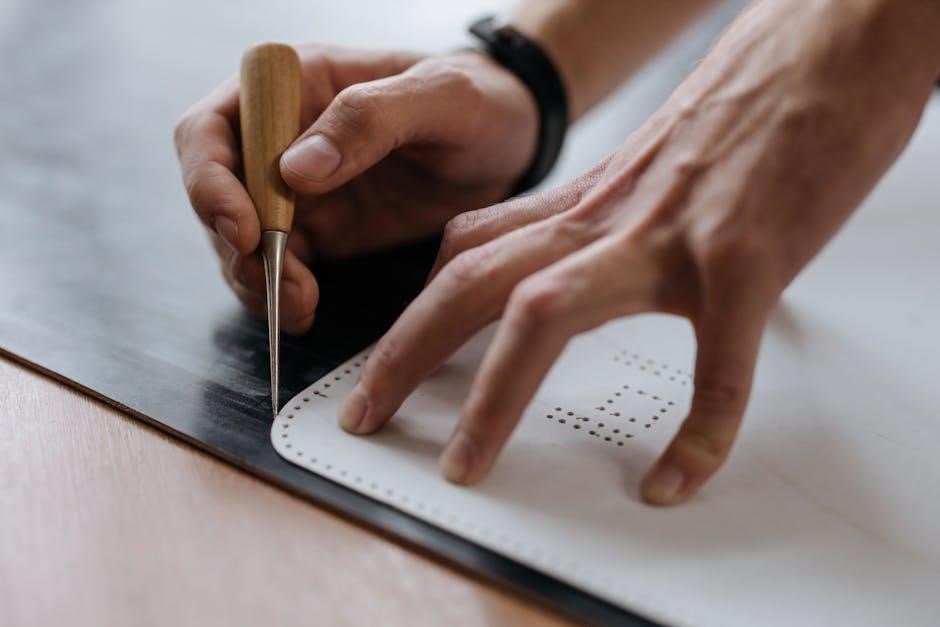Car detailing is a meticulous process of restoring and enhancing a vehicle’s appearance, both inside and out. It goes beyond a standard car wash, focusing on perfection and protection, satisfying enthusiasts who strive for showroom-quality results and long-term maintenance benefits.
1.1 What is Car Detailing?
Car detailing is a meticulous process of thoroughly cleaning, restoring, and enhancing a vehicle’s appearance, both inside and out. It involves a series of steps that go beyond a standard car wash, focusing on perfection and longevity. Detailing addresses every aspect of the vehicle, from the paintwork and glass to the upholstery and trim. The goal is to restore the car’s original shine, protect its surfaces, and enhance its overall value. Whether for personal satisfaction or resale purposes, detailing ensures the vehicle looks its best and maintains its condition over time. It’s a blend of art and precision, appealing to enthusiasts and professionals alike.
1.2 The Importance of Car Detailing
Car detailing is essential for maintaining a vehicle’s condition and appearance. It protects the car’s surfaces from environmental damage, preserves its resale value, and enhances its overall appeal. Regular detailing prevents paint fade, clears contaminants, and ensures interior cleanliness, creating a hygienic environment for drivers and passengers. A well-detailed car reflects pride in ownership and attention to detail, offering satisfaction and confidence on the road. Beyond aesthetics, detailing safeguards against long-term wear and tear, making it a worthwhile investment for car enthusiasts and owners alike. It’s a proactive approach to maintaining a vehicle’s health and beauty, ensuring it remains in prime condition for years to come.
1.3 Benefits of Regular Detailing
Regular car detailing offers numerous benefits, including cost savings, long-term protection, and enhanced vehicle satisfaction. By maintaining your car’s condition, you prevent costly repairs and extend its lifespan. Detailing protects paint from fading, clears contaminants, and preserves interior quality, ensuring a clean and hygienic environment. It also boosts resale value, making your car more attractive to potential buyers. Additionally, detailing enhances your driving experience, providing pride and confidence in your vehicle’s appearance. Whether for personal satisfaction or practical reasons, regular detailing is a smart investment that protects your car and keeps it looking its best for years to come.

Exterior Car Detailing
Exterior car detailing focuses on cleaning, protecting, and restoring your vehicle’s exterior surfaces to achieve a showroom-like appearance and lasting protection against environmental elements.
2.1 Washing and Rinsing Techniques
Proper washing and rinsing are crucial for exterior detailing. Start with a pressure washer to remove loose debris, then use a two-bucket method with microfiber towels to avoid scratches. Circular motions can mar the paint, so opt for straight, overlapping strokes. Ensure the vehicle is cool to prevent soap evaporation. Rinse thoroughly to remove all suds before drying. Avoid using household cleaners, as they can damage the paint. For tough contaminants, a pre-soak or rinse aid can help. Always rinse from top to bottom to prevent dirt from resettling. This step sets the foundation for a flawless detailing process.
2.2 Paint Correction and Polishing
Paint correction and polishing are essential steps to restore a vehicle’s paintwork to its original brilliance. This process involves removing imperfections like scratches, swirl marks, and oxidation using specialized polishes and buffing pads. Orbital polishers are preferred for beginners, as they minimize the risk of damaging the paint. Start with a coarse compound to address deeper flaws, then switch to finer polishes for a high-gloss finish. Always work in small, controlled areas and avoid overheating the paint. Proper techniques ensure a smooth, even surface. Polishing not only enhances appearance but also prepares the paint for protective coatings like wax or ceramic sealants, ensuring long-lasting results.
2.3 Cleaning and Protecting Exterior Glass
Cleaning and protecting exterior glass is crucial for visibility and safety; Use a high-quality glass cleaner with a microfiber towel to avoid streaks and scratches. Avoid household cleaners, as they may contain harmful chemicals. For water spots, use a rinse aid or water-repellent coating. Regular cleaning prevents mineral deposits from hard water. Apply ceramic coatings or rain-repellent treatments for long-term protection. Avoid using paper towels, as they can leave streaks. Clean windows in a shaded area to prevent evaporation lines. For tough stains, use a glass polish, but avoid circular motions to prevent hazing. Proper glass care enhances clarity and durability, ensuring optimal visibility while driving.
2.4 Wheel and Tire Detailing
Wheel and tire detailing is essential for a polished look. Start by rinsing wheels with a pressure washer to remove loose debris. Use a wheel cleaner suitable for your wheel type, avoiding harsh acids on aluminum. Brush tires and wheels to remove stubborn grime. Rinse thoroughly and dry with microfiber towels. Apply a tire dressing to restore rubber’s shine and protect against cracking. For wheels, use a sealant or wax to prevent brake dust buildup. Regular detailing prevents corrosion and maintains a sleek appearance. Avoid using household cleaners, as they can damage finishes. Proper care ensures your wheels and tires remain in pristine condition, enhancing your car’s overall aesthetics. Consistency is key to maintaining their look and longevity.
2.5 Drying and Final Touches
Drying is a critical step in car detailing to prevent water spots and ensure a pristine finish. Use a microfiber towel or drying aid like Optimum No Rinse to gently absorb moisture. Avoid air drying, as it can leave mineral deposits. Start from the top and work downward, ensuring all surfaces are dry. Pay attention to areas prone to water pooling, such as mirrors and spoilers. For a flawless finish, use a separate, absorbent towel for drying. This step enhances the paint’s clarity and protects it from streaks. Proper drying completes the detailing process, leaving your car with a showroom-like appearance and a smooth, even surface.

Interior Car Detailing
Interior detailing involves thorough cleaning and restoration of a car’s inside, focusing on surfaces, upholstery, carpets, and dashboards. It ensures a fresh, hygienic, and visually appealing environment, enhancing comfort and value.
3.1 Vacuuming and Cleaning Interior Surfaces
Vacuuming is the first step in interior detailing, focusing on carpets, floor mats, and crevices. A powerful shop vac is ideal for deep cleaning, tackling dirt and debris effectively. Use brushes or upholstery attachments to gently remove embedded particles. For hard surfaces, damp microfiber cloths or specialized cleaners like Meguiars Quik Interior Detailer work well. Avoid harsh chemicals that may damage materials. Wipe down dashboards, consoles, and doors, paying attention to high-touch areas like buttons and handles. For stubborn stains, apply a small amount of cleaner and blot gently. Finish bybuffing surfaces with a dry microfiber towel to remove streaks and restore shine.
3.2 Upholstery and Seat Cleaning
Upholstery cleaning requires careful attention to maintain fabric or leather integrity. Start by vacuuming seats to remove loose debris. For cloth upholstery, use a fabric cleaner, gently scrubbing stains with a soft-bristle brush. Avoid over-saturating to prevent mold. For leather, apply a gentle leather cleaner, wipedown with a microfiber towel. Condition leather afterward to maintain suppleness. For tough stains or pet hair, use a lint roller or adhesive remover. Always test a small, inconspicuous area first. Blot spills immediately with a clean, damp microfiber towel. Avoid harsh chemicals or excessive water to prevent damage. Regular cleaning extends the life of your car’s interior.
3;3 Carpet and Floor Mat Detailing
Carpet and floor mat detailing involves thorough cleaning to remove dirt, stains, and odors. Start by removing mats and vacuuming thoroughly, paying attention to crevices. Pre-treat stains with a carpet cleaner or upholstery shampoo, gently scrubbing with a stiff brush. Rinse with a damp microfiber towel and allow to dry. For tough odors, sprinkle baking soda, let sit, then vacuum. Floor mats should be scrubbed, rinsed, and dried separately. Regular cleaning prevents mold and mildew, ensuring a fresh interior. Avoid using harsh chemicals that could damage materials. Proper drying is crucial to prevent moisture buildup and lingering odors.
3.4 Dashboard and Trim Restoration
Dashboard and trim restoration focuses on reviving surfaces to their original condition. Start by gently vacuuming dust and debris. Use a microfiber towel dampened with a mild interior cleaner to wipe down surfaces, avoiding harsh chemicals that can damage materials. For stubborn stains or UV damage, apply a specialized trim restorer or leather conditioner. Buff the area with a clean microfiber towel to restore shine and protect against future wear. Avoid using household products, as they may contain abrasive ingredients. Regular maintenance with a UV-protectant spray helps preserve the dashboard and trim, ensuring a polished and protected interior appearance for years to come.

Paint Protection and Enhancement
Paint protection and enhancement involve safeguarding the vehicle’s finish while restoring its vibrancy. Techniques like waxing and ceramic coatings offer durability and UV resistance, preserving the car’s showroom appearance.
4.1 Understanding Wax vs. Ceramic Coatings
Wax and ceramic coatings are popular paint protection options, each offering unique benefits. Wax provides a temporary barrier against contaminants and UV rays, enhancing gloss but requiring frequent reapplication. Ceramic coatings, however, form a durable, long-lasting protective layer that repels water, dirt, and harmful elements, reducing maintenance needs. While wax is easier to apply and remove, ceramic coatings offer superior durability and protection, making them a preferred choice for long-term paint preservation. Understanding these differences helps detailers choose the best option for their vehicle’s needs, balancing convenience, cost, and desired protection levels.
4.2 Applying Protective Coatings
Applying protective coatings requires careful preparation and execution. Start with a clean, dry surface, ensuring no contaminants remain. For wax, apply a small amount using a circular motion with a microfiber pad, then buff to a high shine. Ceramic coatings demand more precision—use a clean, lint-free cloth to spread a thin, even layer, working section by section. Allow the coating to cure as per product instructions before final buffing. Proper technique ensures maximum protection and durability, enhancing your vehicle’s appearance while safeguarding its paint from environmental threats. Attention to detail is key for a flawless, professional finish.
4.3 Maintaining Paint Protection
Maintaining paint protection requires regular upkeep to ensure longevity. Wash your car every two weeks using a mild soap and a soft microfiber towel to avoid scratches. Avoid using harsh chemicals or abrasive materials that can strip away protective coatings. For ceramic coatings, touch-ups every few months can reinforce protection. Wax should be reapplied every 2-3 months, depending on exposure to elements. Use a clean, dry microfiber towel to buff the surface after washing, ensuring no water spots form. Regular maintenance not only preserves the protective layer but also keeps your car looking pristine. Consistency is key to sustaining the durability of paint protection treatments.

Advanced Detailing Techniques
Advanced detailing techniques, such as clay bar treatments and machine polishing, refine and enhance a vehicle’s finish, offering professional-level results for enthusiasts seeking perfection in their car’s appearance.

5.1 Clay Bar Treatment
A clay bar treatment is a crucial step in advanced detailing, removing contaminants like tar and overspray that washing alone can’t eliminate. Using a clay bar, detailers gently glide it across the paint, glass, and metal surfaces, pulling out embedded impurities. This process smooths the surface, enhancing the effectiveness of subsequent polishes and protective coatings. Proper lubrication with a detailing spray is essential to avoid scratching. Regular clay barring maintains the vehicle’s exterior integrity, ensuring a pristine finish and optimal protection. It’s a technique that bridges the gap between cleaning and restoration, elevating the car’s appearance to a professional standard.
5.2 Machine Polishing for Beginners
Machine polishing is a powerful technique for correcting paint imperfections like scratches and swirls. For beginners, a dual-action polisher is recommended, as it’s safer and easier to control than a rotary polisher. Start with a cutting pad and a light compound to address deeper imperfections, then switch to a polishing pad and a finer product for a high-gloss finish. Work in small, controlled sections, maintaining steady, overlapping passes. Avoid excessive pressure or high speeds, which can damage the paint. Practice on a test panel first to build confidence and skill. Regular polishing maintains the paint’s health and clarity, ensuring a professional-grade finish.
5.3 Interior Odor Removal
Interior odor removal is crucial for a fresh, clean car environment. Common odors stem from spills, smoke, or moisture. Start by identifying the source and thoroughly vacuuming surfaces. Use a shop vac for deep cleaning, especially in carpets and crevices. Apply specialized cleaning products like Meguiar’s or Optimum No Rinse to eliminate stains and odors. Neutralize smells with baking soda or odor-neutralizing sprays. Avoid harsh chemicals that can damage materials. For persistent odors, consider professional ozone treatment but use caution to avoid overuse. Regular cleaning and ventilation are key to preventing odors from returning, ensuring a pleasant interior atmosphere.

DIY vs. Professional Detailing
DIY detailing saves money and builds skills, but requires time and effort. Professional detailing offers expert results and advanced techniques, ideal for those seeking perfection without the hassle.
6.1 Cost Considerations
DIY detailing can save money by avoiding professional fees, but it requires an initial investment in tools and products. Pressure washers, microfiber towels, and cleaning supplies add up, though they pay off over time. Professional detailing offers convenience but comes with higher costs, especially for advanced services like ceramic coatings. For DIY enthusiasts, long-term savings on maintenance and repairs make the effort worthwhile. However, professionals provide expert results, which may justify the expense for perfectionists or those with high-value vehicles. Balancing budget and desired outcomes helps decide whether DIY or professional detailing is more cost-effective in the long run.
6.2 Time and Effort Required
DIY detailing demands significant time and effort, especially for beginners. A thorough detail can take several hours, requiring patience and attention to detail. Exterior processes like washing, polishing, and protecting the paint are time-consuming, while interior detailing involves vacuuming, cleaning upholstery, and restoring surfaces. Professionals, on the other hand, offer convenience, completing the job faster due to their expertise and specialized tools. For those with busy schedules, professional detailing saves time but costs more. DIY detailing is rewarding for enthusiasts who enjoy hands-on work, but it requires a commitment to learning and practicing techniques to achieve professional-quality results consistently.
6.3 When to Choose Professional Detailing
Professional detailing is ideal when time is limited or for achieving flawless results. Experts use advanced techniques and specialized tools, ensuring superior outcomes, especially for tasks like paint correction or ceramic coating. For high-value or vintage vehicles, professionals minimize risks of damage; Special occasions, like selling a car or preparing for a show, also warrant professional detailing. Their expertise in handling complex issues, such as interior odor removal or deep paint restoration, ensures precision and care. While DIY detailing is cost-effective, professionals offer convenience, efficiency, and unmatched quality, making them the best choice for those seeking perfection without the effort and time investment.

Tools and Products for Detailing
Essential tools include microfiber towels, pressure washers, and detailing brushes. Products like car wash soap, wax, and ceramic coatings are vital for achieving a professional finish and lasting protection;
7.1 Essential Cleaning Supplies
Microfiber towels are a must for scratch-free cleaning. A quality car wash soap, free of wax additives, ensures a clean slate for protection. Glass cleaner specifically designed for automotive use prevents streaks and maintains clarity. For interiors, a gentle upholstery cleaner and a dashboard-specific product are recommended to avoid damage. Pressure washers are ideal for tough exterior contaminants, while brushes help reach tight spaces. Avoid harsh chemicals that can harm surfaces. Opt for pH-neutral products to maintain the vehicle’s finish. These supplies form the foundation of a successful detailing process, ensuring effectiveness without compromising the car’s materials or appearance.
7.2 Best Microfiber Towels for Detailing
Microfiber towels are indispensable in car detailing due to their softness and effectiveness. Opt for looped microfibers with unfinished edges to minimize scratching risks. Fluffy towels may feel softer but can cause microscratches. High-quality options like the Autofiber Dreadnought drying towel offer exceptional absorbency and safety for paint surfaces. Avoid using household towels, as they can damage the finish. Always separate washing and drying towels to prevent cross-contamination of dirt and chemicals. Investing in durable, machine-washable microfiber towels ensures long-term cost savings and professional-level results in maintaining your vehicle’s pristine appearance.
7.3 Recommended Pressure Washers
A pressure washer is a must-have tool for effective car detailing, as it efficiently removes tough contaminants and grime. When choosing a pressure washer, consider one with adjustable pressure settings to avoid damaging delicate surfaces. Electric models are ideal for most detailing tasks, offering sufficient power without the bulk of gas-powered units. Look for a washer with a flow rate of 1.5 to 2.0 GPM for optimal cleaning. Brands like Sun Joe and Ryobi offer reliable options that balance affordability and performance. A good pressure washer not only speeds up the cleaning process but also ensures a deeper clean, making it a worthwhile investment for any detailing enthusiast.

Common Mistakes to Avoid
Common mistakes in car detailing include using the wrong cleaning products, improper washing techniques, and insufficient drying, which can lead to scratches or water spots. Avoid these errors by using high-quality tools and following a systematic approach to ensure a flawless finish.
8.1 Overlooking Small Details
Overlooking small details is a common mistake in car detailing that can significantly impact the final result; Many enthusiasts focus on major areas like paint and upholstery but neglect smaller elements such as air vents, crevices, and trim. These overlooked spots can accumulate dust and dirt, making the car appear less polished. For instance, forgetting to clean between seat cushions or under floor mats can leave the interior looking unkempt. Similarly, ignoring tiny paint imperfections or not properly drying tight spaces can lead to water spots or damage. Paying attention to these often-missed areas ensures a truly professional finish and enhances the car’s overall appearance.
8.2 Using the Wrong Cleaning Products
Using the wrong cleaning products is a common mistake that can damage your car’s surfaces. Many enthusiasts unknowingly use household cleaners or multi-purpose sprays, which can strip wax, dull paint, or harm interior materials. For example, using a harsh chemical on leather seats can cause cracking, while abrasive cleaners can scratch glass or trim. Always opt for products specifically designed for automotive use, such as pH-neutral car wash soaps or gentle leather conditioners. Using the right products ensures safety, effectiveness, and long-term protection for your vehicle’s surfaces, preserving its appearance and value.
8.3 Improper Drying Techniques
Improper drying techniques can lead to water spots, mineral deposits, and even scratches. Allowing the car to air dry is a common mistake, as water droplets can leave behind unsightly spots. Instead, use a high-quality microfiber drying towel to gently pat the vehicle dry, starting from the top and working downward. Avoid rubbing vigorously, as this can create scratches. For optimal results, use a separate microfiber towel for drying than the one used for washing to prevent cross-contamination of dirt and debris. Proper drying ensures a spotless finish and protects the paint from damage caused by water evaporation.
Car detailing transforms your vehicle, offering satisfaction and preserving its value. Regular detailing enhances appearance, protects surfaces, and saves money. Master these techniques for long-term benefits.
9.1 Final Tips for Success
Consistency is key to maintaining your car’s pristine condition. Regular detailing prevents damage and ensures longevity. Always use high-quality products tailored to your vehicle’s needs. Patience is essential—rush jobs often lead to subpar results. Practice makes perfect, so refine your techniques over time. Don’t overlook small details, as they make a significant difference. Stay organized with a detailing schedule to keep track of tasks. Finally, take pride in your work; a well-detailed car reflects dedication and care. By following these tips, you’ll achieve professional-grade results and enjoy the satisfaction of owning a vehicle that looks and feels its best.

9.2 The Satisfaction of a Well-Detailed Car
There’s immense satisfaction in transforming your vehicle from ordinary to extraordinary through detailing. A well-detailed car exudes pride and joy, reflecting your dedication to its care. The process not only restores its showroom shine but also ensures its longevity, protecting it from wear and tear. The meticulous attention to detail, from polished paint to pristine interiors, creates a sense of accomplishment. Whether it’s the admiration of others or the personal satisfaction of a job well done, a perfectly detailed car is a testament to your hard work and love for your vehicle, making every drive a delightful experience.

